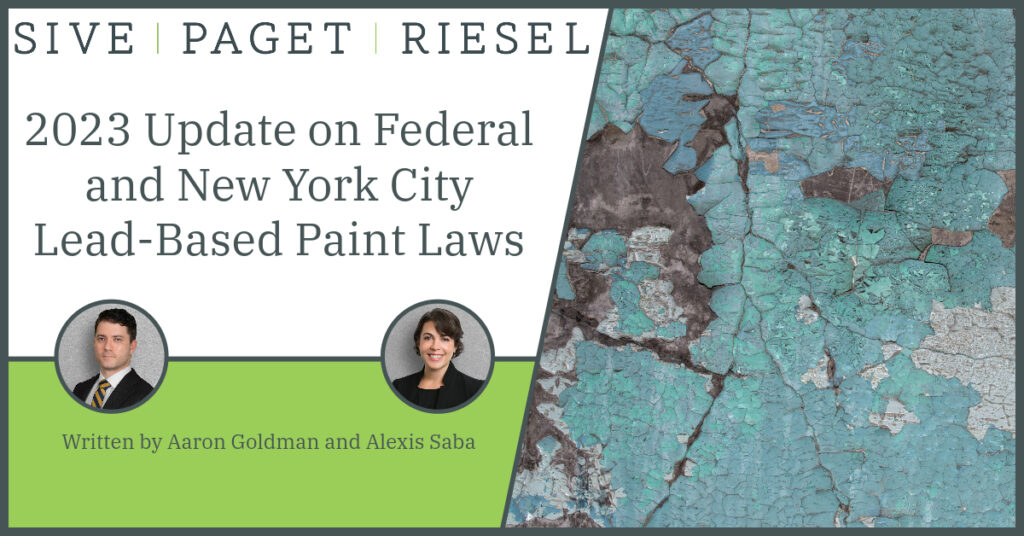Blog

2023 Update on Federal and New York City Lead-Based Paint Laws
This year has seen notable changes and clarifications to Federal and New York City lead-based paint standards for residential properties. These provisions relate to lead paint investigations, testing, remediation, and penalties that may impact compliance planning for building owners and managers. Because these legal changes were adopted after SPR’s May 4, 2023 webinar on the basics of lead-based paint regulation, we summarize the key points below.
Local Laws 111 and 123 of 2023 are the two most substantive new City laws regarding lead-based paint testing and remediation. Effective on June 8, 2024, Local Law 111 clarifies that property owners who are subject to the one-time lead-based paint testing requirement of Local Law 31 of 2020 must also ensure that their independent, EPA-certified inspector tests for lead-based paint in common areas, not just individual apartment units. While this provides much-needed clarity to residential building owners and property managers, it will also significantly expand the scope of required x-ray fluorescence (XRF) lead-based paint testing.
Local Law 111 also steps up enforcement measures. When the Department of Housing Preservation and Development (HPD) inspects a unit due to a lead-based paint complaint, HPD must now also visually inspect common areas like hallways near the unit. Local Law 111 increases the penalties for violations found in common areas of residential properties that house children under six years of age (CU6). The law specifies that the existence of peeling lead-based paint or lead-based paint on deteriorated subsurfaces (e.g., rotting wood, rusting metal) in such common areas constitutes an immediately hazardous Class C violation. Additionally, now HPD is required to inspect common areas when responding to a lead-based complaint in CU6 buildings. Property managers and landlords should take note of this change, as Class C violations are subject to increased fines and require immediate correction.
Effective on September 1, 2024, Local Law 123 amends the lead-based paint remediation requirements that, prior to the law’s effective date, only apply upon unit turnover. With the enactment of Local Law 123, owners of buildings constructed before 1960 must remediate certain lead-based paint before unit turnover if turnover occurs (a) after July 1, 2027 where a CU6 resides in the building as of January 1, 2025, or (b) three years after a CU6 begins to reside in the building. By these dates, building owners must remove or permanently cover all lead-based paint on all friction surfaces on doors, door frames, and windows—or for the windows, install replacement window channels or slides.
These local laws reinforce a new regulation adopted by the New York City Department of Health and Mental Hygiene (DOHMH) in December 2022 that lowers the threshold for reporting and investigating childhood elevated blood-lead levels (EBLLs) from 5 micrograms per deciliter (mcg/dL) to 3.5 mcg/dL. Building owners and operators in New York City should take note that EBLL reporting applies to any child under the age of 18 and triggers a mandatory investigation by DOHMH, including an inspection of the lead-based paint hazards in the child’s home and any location where they spend at least five hours per week.
At the federal level, EPA has proposed regulations regarding lead dust standards. Based on a recent decision by the U.S. Court of Appeals for the Ninth Circuit, EPA is proposing to separate the dust-lead hazard standard (DLHS) from the dust-lead clearance level (DLCL)—and to make both standards more stringent. The DLHS is relevant for determining what constitutes a lead-based paint hazard where the trigger is a friction surface that produces dust. The DLCL is relevant for determining when lead-based paint abatement is complete based on dust wipe clearance testing. The proposed change to the DLHS has garnered the most attention because EPA seeks to lower the standard from 10 milligrams per square foot (mg/ft2) for floors and 100 mg/ft2 for window sills to the less-defined standard of “any reportable level of dust-lead”—meaning “any level greater than or equal to the lowest value a laboratory can reliably report to a client or the regulated community.” EPA acknowledges that this standard will vary based on the capabilities of individual laboratories.
The proposed EPA rule also revises the definition of abatement so that any trigger based on dust lead levels will align with the DLCL rather than the DLHS. This change would ensure that the dust lead trigger for abatement matches post-abatement dust wipe clearance levels.
Finally, EPA is proposing to update the lead disclosure language required in sale and lease documentation to address a drafting error. Building owners and managers should watch for publication of the final rule so that they can incorporate the updated language into their closing and lease forms.